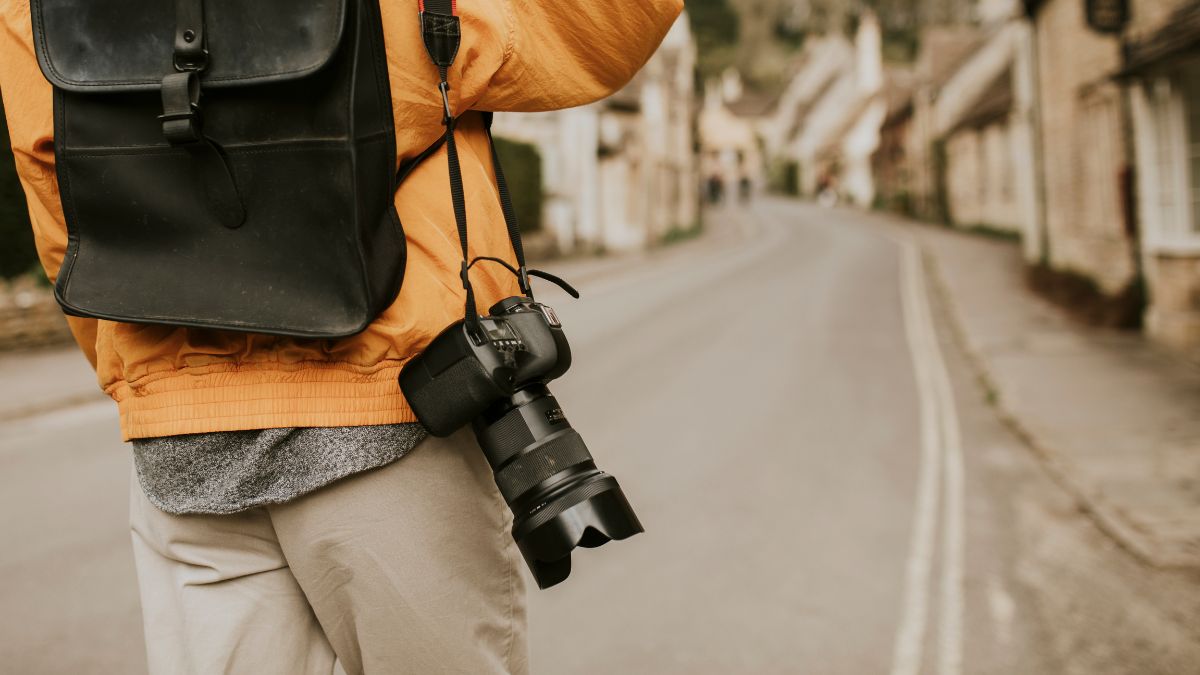Blog
Journeyman Camera vs. Modern Equipment: Which Is Right for You?

Introduction to the two options
In a world where technology evolves at lightning speed, the debate between classic photography tools and modern equipment continues to ignite passion among enthusiasts. Enter the journeyman camera—a beloved relic that captures not just images but also stories from a bygone era. On the flip side, we have sleek, high-tech gear packed with features designed to elevate your photography game. So how do you choose? Whether you’re an aspiring photographer or a seasoned pro looking to refine your craft, understanding the strengths and weaknesses of both options is crucial for making informed decisions. Let’s dive into this fascinating comparison!
Pros and Cons of the Journeyman Camera
The Journeyman camera is a classic choice for many photographers. Its design embodies craftsmanship and nostalgia, appealing to those who appreciate traditional photography.
One major advantage is its simplicity. Without the distractions of advanced features, users can focus on composition and light. This encourages creativity and skill development.
However, there are downsides. The learning curve can be steep for beginners unfamiliar with manual settings. Adjusting exposure or shutter speed requires attention and practice.
Durability is another plus; these cameras often withstand years of use if properly maintained. But repairs can be challenging due to limited availability of parts.
Additionally, film costs add up over time compared to digital options that offer unlimited shots without extra fees.
Choosing a Journeyman means embracing limitations while fostering artistic growth in an analog world full of instant gratification.
Pros and Cons of Modern Equipment
Modern equipment offers impressive versatility. With advanced features like autofocus, high ISO capabilities, and video recording options, photographers can capture stunning images in various conditions.
One significant advantage is the convenience of digital storage. Thousands of photos fit on a single memory card, reducing the need for physical film rolls. Instant feedback through LCD screens allows for immediate adjustments.
However, there are downsides to consider. The complexity of modern gear can be overwhelming for beginners. Learning curves may deter some from fully enjoying photography.
Additionally, reliance on technology means that battery life becomes crucial. A dead battery can halt a session unexpectedly.
Modern equipment often comes with higher price tags and ongoing software updates that require investment over time. Balancing these aspects is vital when choosing your ideal photography setup.
Comparing Cost and Maintenance
When it comes to cost, the journeyman camera often stands out as a more budget-friendly option. Its simplicity means fewer moving parts and less expensive repairs.
Modern equipment, while offering advanced features, can be significantly pricier. Not only do you pay for the initial investment, but ongoing upgrades and accessories can add up quickly.
Maintenance is another factor to consider. Journeyman cameras typically require minimal upkeep. A good clean and occasional checks keep them functioning well.
On the other hand, modern devices demand regular maintenance due to their complex systems. Firmware updates and software compatibility are crucial aspects that need attention.
Consider your willingness to invest time and money into upkeep as you weigh these options. This decision could heavily impact your photography journey in both practicality and enjoyment.
The Importance of Understanding Your Needs
Choosing between a journeyman camera and modern equipment hinges on understanding your unique needs as a photographer. Every individual has different preferences, styles, and technical requirements.
Identify what you shoot most often. Is it portraits? Landscapes? Events? This clarity will guide your decision-making process.
Consider skill level too. A beginner might find the simplicity of modern gear appealing, while an experienced photographer could appreciate the craftsmanship of traditional options.
Think about how you plan to use the camera. Will it be for casual outings or professional projects? Your approach should influence whether you lean towards flexibility or classic reliability.
Don’t forget about comfort and ergonomics. The right fit can enhance your shooting experience significantly. Prioritizing these aspects will lead to more enjoyable photography sessions in the long run.
Advancements in Technology
Technology has rapidly transformed photography in recent years. Digital cameras continue to evolve, boasting higher resolutions and enhanced sensors that capture stunning images even in low light.
Smartphones now come equipped with powerful camera systems. With multiple lenses and advanced editing features, they provide an accessible platform for aspiring photographers.
Moreover, artificial intelligence plays a significant role today. AI-driven algorithms can automatically optimize photos by adjusting colors and reducing noise, making it easier than ever to achieve professional-quality results.
Then there are mirrorless systems gaining traction among professionals. They offer compact designs without sacrificing performance, allowing photographers greater mobility on shoots.
Additionally, cloud storage solutions ensure safe backing up of photographs while providing easy access from anywhere. The seamless integration of technology into the photographic process has revolutionized how we create and share our visual stories.
Finding the Right Balance Between Traditional and Modern
Finding the right balance between traditional and modern photography equipment can be tricky. Each style offers unique benefits that cater to different needs.
A journeyman camera often brings a sense of nostalgia and artistry. It encourages you to slow down, think creatively, and appreciate the craft. Many photographers cherish this tactile experience.
On the flip side, modern equipment provides convenience and versatility. Features like autofocus, image stabilization, and advanced sensors make capturing moments easier than ever before. They cater to busy lifestyles while still producing stunning images.
The key lies in blending both worlds. Embrace the charm of analog techniques while utilizing digital advancements when necessary. This harmonious approach allows for creativity without sacrificing efficiency.
Experimenting with various setups will help you discover what resonates most with your artistic vision. It’s about finding joy in your process, regardless of the tools at hand.
Conclusion
When choosing between a journeyman camera and modern equipment, it boils down to personal preference and specific needs. A journeyman camera offers a timeless approach to photography that captures the essence of traditional craftsmanship. It encourages photographers to develop their skills without relying too heavily on advanced technology.
On the other hand, modern equipment brings convenience and efficiency. With features like autofocus, image stabilization, and high ISO capabilities, it caters well to fast-paced environments or those who want immediate results.
Understanding your own photographic goals is crucial in making this decision. Whether you’re drawn to the nostalgia of film or the sleekness of digital gear will depend on what you hope to achieve with your art.
As technology continues its rapid advancement, finding a balance between these two worlds becomes essential for many photographers. Embracing both traditional techniques while leveraging modern tools can lead to unique creative expressions.
Whether you lean towards a journeyman camera or opt for the latest innovations depends on how they align with your vision as an artist. Explore both options thoughtfully; each has something valuable to offer in your journey through photography.
Blog
Selena Green: The Voice Behind the Hits – An In-Depth Profile

Introduction to Selena Green and her music career
Selena Green has become a household name in the music industry, captivating audiences with her powerful voice and heartfelt lyrics. With hits that resonate across genres, she’s not just an artist; she’s a phenomenon. From the moment fans first heard her debut single, it was clear that Selena Green was destined for greatness. But who is this talented musician behind the chart-topping tracks? Join us as we dive into the life and career of Selena Green, exploring her journey from humble beginnings to international stardom. Get ready to uncover the story behind the voice that has left an indelible mark on music today!
Early Life and Musical Influences
Selena Green was born into a family that cherished music. Growing up in a small town, she found herself surrounded by diverse sounds. Her parents played everything from classic rock to soulful jazz. This rich musical environment ignited her passion early on.
As a child, Selena would often sing along with her favorite artists. Icons like Aretha Franklin and Whitney Houston served as major influences during her formative years. Their powerful voices inspired her to develop her own unique style.
Local community events provided the young singer with opportunities to perform. She participated in school talent shows and local festivals, captivating audiences with her raw talent. Each performance fueled her ambition further, solidifying music’s role as an integral part of her life.
Selena’s upbringing laid the foundation for what would become an extraordinary career filled with rhythm and soul.
Rise to Fame with Debut Album
Selena Green’s debut album catapulted her into the spotlight. Released in 2018, it showcased her distinctive voice and songwriting prowess.
Fans were instantly drawn to tracks like “Chasing Shadows” and “Echoes of You.” These songs became anthems for a generation searching for authenticity in music. Critics praised her ability to blend genres, creating a fresh sound that resonated with many.
The album’s success led to sold-out shows across the country. Selena’s performances radiated energy, captivating audiences everywhere she went. Her connection with fans was palpable; they sang along word-for-word at every concert.
Radio stations quickly picked up her hits, solidifying Selena as a rising star. The accolades poured in as award nominations followed suit. It was clear: this was just the beginning of something great for Selena Green.
Personal Life and Challenges Faced
Selena Green’s journey hasn’t been without its obstacles. Growing up in a small town, she faced the challenge of limited resources and opportunities. The music industry can be ruthless, but Selena found her strength through resilience.
Her rise to fame brought unexpected pressures. Balancing public scrutiny with personal life proved daunting at times. She often felt overwhelmed by expectations from fans and critics alike.
Navigating relationships has also posed difficulties for Selena. Maintaining connections while traveling and working tirelessly can strain even the strongest bonds. Despite these challenges, she remains grounded and values her close friends and family above all.
Mental health has been another hurdle for Selena. She bravely opened up about anxiety during interviews, shedding light on an issue many face but few discuss openly within the entertainment world. Through therapy and self-care practices, she continues to prioritize her well-being as a vital part of her journey in music.
Evolution of Sound and Style
Selena Green’s journey through music has been nothing short of transformative. Her sound initially focused on pop melodies, infused with a vibrant energy that resonated with fans worldwide. Tracks from her early albums showcased catchy hooks and relatable lyrics.
As she evolved, so did her musical palette. Selena began experimenting with electronic beats and R&B influences, broadening her artistic horizons. This shift allowed for deeper emotional expression in her songwriting.
Her latest works reveal an intriguing blend of genres—soulful ballads alongside upbeat dance tracks. The evolution reflects not just personal growth but also an understanding of the ever-changing music landscape.
Visually, Selena’s style mirrors this progression. From colorful outfits to sophisticated chic looks, each era complements her sonic shifts beautifully. This transformation captures the essence of who she is as a modern artist navigating today’s industry dynamics seamlessly.
Collaborations and Achievements
Selena Green has always been known for her ability to connect with other artists. Her collaborations reflect a diverse range of styles, showcasing her versatility and depth as a musician. Working alongside established names in the industry has expanded her reach and influence.
Tracks like “Echoes,” featuring the talented R&B singer Jordan Blake, pushed boundaries and received critical acclaim. The synergy between their voices created magic that resonated with fans around the globe.
Her achievements go beyond chart-topping hits. Selena’s music won several prestigious awards, including multiple Grammys. Each accolade is a testament to her hard work and dedication.
Beyond individual success, Selena actively supports emerging artists through collaborative projects. She values community within the industry, often mentoring young musicians looking to find their voice.
Every collaboration enriches not only her discography but also solidifies her status as an influential figure in contemporary music.
Impact on the Music Industry
Selena Green has undeniably made her mark on the music industry. Her unique sound blends various genres, inspiring countless artists to explore new musical territories.
With chart-topping hits that resonate with fans across the globe, she has proven that authenticity speaks volumes. Selena’s lyrical depth tackles themes of love, struggle, and empowerment—elements that many find relatable.
As a trailblazer for emerging female artists, she champions individuality and creative freedom. This commitment fosters an environment where diverse voices can flourish in a predominantly male-dominated space.
Her influence also extends beyond music; Selena actively engages in social issues through her platform. From advocating for mental health awareness to supporting marginalized communities, she uses her success responsibly.
Selena Green’s impact is felt not just in sales but also in cultural conversations surrounding artistry and representation within the industry.
Criticisms and Controversies
Selena Green has faced her share of criticisms throughout her career. Some skeptics argue that her sound is overly commercialized, lacking the raw authenticity that many fans crave. They believe she prioritizes mainstream appeal over artistic integrity.
Controversies have also followed Selena regarding her personal choices and public statements. Social media backlash often arises when she expresses opinions on sensitive issues, leading to heated debates among supporters and detractors alike.
Additionally, rumors about her interpersonal relationships with collaborators have at times overshadowed her musical achievements. These whispers can create a cloud of doubt around an artist’s dedication to their craft.
Despite the noise surrounding these criticisms, Selena remains focused on creating music that resonates with her audience. She often uses feedback as motivation to evolve and grow in both artistry and character.
Future Plans and Projects
Selena Green is not one to rest on her laurels. With a string of successful singles under her belt, she is keen on exploring new horizons in music. Fans can expect an exciting blend of genres in her upcoming projects.
She has hinted at collaborations with both established and emerging artists. These partnerships promise to bring fresh sounds that will surprise even the most dedicated listeners.
Additionally, Selena is diving into songwriting for other talents. She aims to share her unique storytelling ability with a wider audience through diverse voices.
Moreover, there are whispers about a concept album focused on personal experiences and social themes. This would mark another evolution in her artistic journey, showcasing depth and insight into pressing issues.
Selena remains committed to live performances, planning an intimate concert series that allows fans to connect with her music up close and personal.
Conclusion: The Legacy of Selena Green
Selena Green has made an indelible mark on the music landscape. Her journey from humble beginnings to iconic status showcases her immense talent and resilience. Each album offers a glimpse into her evolving artistry, reflecting both her personal growth and changing influences.
Her collaborations have brought forth memorable tracks that resonate with fans across generations. Awards and accolades have recognized not just her commercial success but also the impact of her storytelling through music.
Despite facing challenges, Selena’s commitment to her craft remains unwavering. She continues to inspire aspiring artists with authenticity and passion. As she explores new sounds and ventures, the excitement for what’s next in Selena Green’s career builds steadily within the fanbase.
The legacy of Selena Green is one of empowerment, creativity, and unyielding dedication to music—a true testament to what it means to be an artist in today’s world.
-

 TECHNOLOGY1 year ago
TECHNOLOGY1 year agoTop 5 Tips for Mastering in_a_dndmixin_drag in Your Campaigns
-

 TOPIC12 months ago
TOPIC12 months agoExploring the History and Culture of Rosewellsk
-

 TECHNOLOGY1 year ago
TECHNOLOGY1 year agoYMoviesHD vs Other Streaming Platforms: A Comprehensive Comparison
-

 TOPIC1 year ago
TOPIC1 year agoBehind the Scenes: The Philosophy and Vision of PhmHaven
-

 TOPIC1 year ago
TOPIC1 year agoThe Rise of Tribute Printed Pics: Honoring Life Through Photography
-

 TOPIC12 months ago
TOPIC12 months agoA Beginner’s Journey with Lwedninja: From Novice to Pro
-

 TOPIC12 months ago
TOPIC12 months agoIs Finizona Free? Unpacking the Costs Behind This Popular Platform
-

 TOPIC12 months ago
TOPIC12 months agoDecoding m0therearf: Why This Buzzword Matters in Today’s Culture
